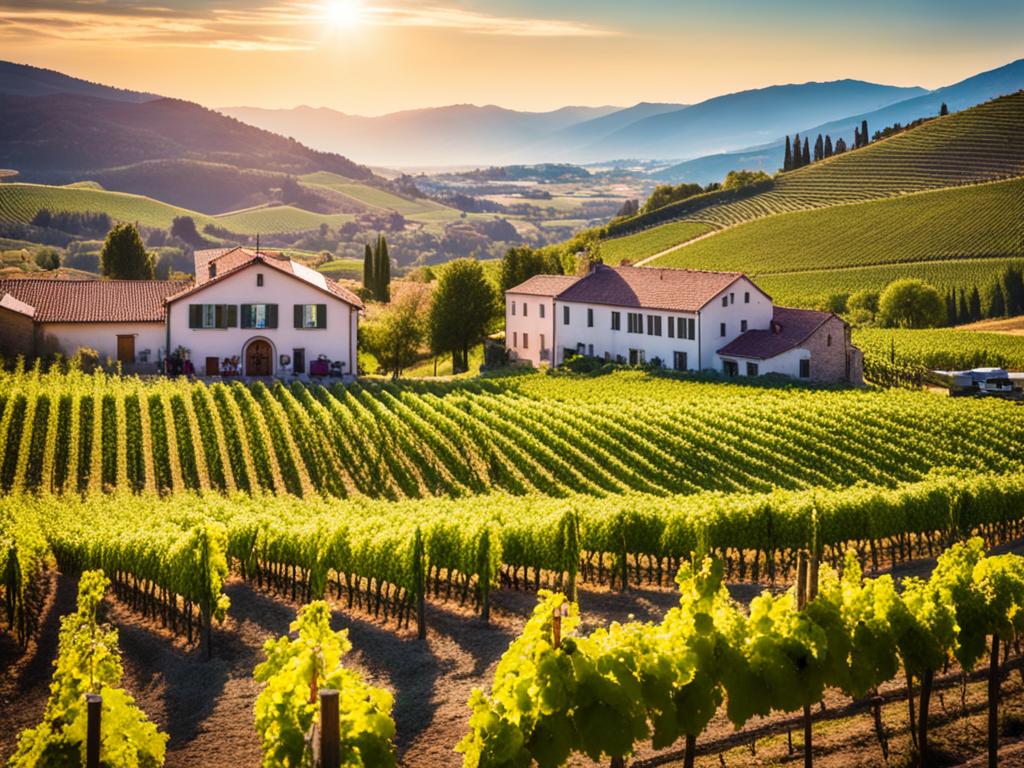Welcome to a journey through time as we uncover the captivating history of wine. From its origins in ancient civilizations to the thriving vineyards of today, wine has truly stood the test of time. Discover the fascinating evolution of winemaking techniques, explore the iconic wine regions that have shaped the industry, and understand the profound impact wine has had on culture and society.
Join us as we uncork the secrets of the history of wine and toast to its enduring legacy. Cheers!
Key Takeaways:
- The history of wine spans ancient civilizations to modern times
- Winemaking techniques have evolved over centuries, from clay jars to oak barrels
- Iconic wine regions, such as Bordeaux and Napa Valley, have rich historical significance
- Wine has played a significant role in culture and society, symbolizing celebration and connection
- The story of wine continues to evolve, leaving a lasting legacy for generations to come
Wine in Ancient Civilizations: A Glimpse into the Past
Step back in time and discover the captivating role of wine in ancient civilizations. Journey through the ancient cultures of Egypt, Greece, and Rome, and uncover the deep-rooted connection between wine and the rituals, beliefs, and traditions of these early societies.
In ancient Egypt, wine was not only a beverage but also a symbol of luxury and divine connection. It was deeply intertwined with religious practices, where it played a significant role in ceremonies and offerings to the gods. The Egyptians believed that wine possessed spiritual properties, linking the mortal realm to the divine.
Ancient Greece, known as the birthplace of Western civilization, celebrated wine as a staple of their culture. The Greeks believed that wine was a gift from the gods, bestowed upon them by Dionysus, the god of wine and revelry. It was an integral part of their social gatherings and banquets, enhancing the enjoyment of music, poetry, and philosophical discussions.
The Romans, influenced by the Greeks, further elevated the status of wine in their society. They considered wine as an essential element of their daily lives, often consumed with meals or offered at festive occasions. It became a symbol of wealth, power, and social status, with distinct drinking traditions and etiquette.
The ancient Romans had a saying: “In wine, there is truth” (“In vino veritas”). It reflected their belief that wine had the power to reveal one’s true nature and remove inhibitions, fostering open and honest communication.
Throughout these ancient civilizations, wine was not only valued for its taste but also appreciated for its medicinal properties. It was believed to have healing effects and was used as a remedy for various ailments.
As we explore the history of wine in ancient civilizations, it becomes evident that it held immense cultural, social, and religious significance. It shaped their traditions, rituals, and even their understanding of the divine.
| Ancient Civilizations | Beliefs and Traditions |
|---|---|
| Egypt | Wine as a symbol of luxury and divine connection. Use in religious ceremonies. |
| Greece | Wine as a gift from the gods. Integral part of social gatherings, art, and philosophy. |
| Rome | Wine as a symbol of wealth and power. Distinct drinking traditions and etiquettes. |
By shedding light on the presence of wine in ancient civilizations, we can gain a deeper understanding of its enduring allure and its impact on the development of winemaking techniques, traditions, and cultures throughout history.
The Evolution of Winemaking Techniques: From Clay Jars to Oak Barrels
In the world of winemaking, a rich tapestry of techniques and innovations have shaped the creation of this beloved beverage over centuries. From the humble beginnings of clay jars to the iconic oak barrels, the evolution of winemaking techniques has been a fascinating journey of experimentation, refinement, and discovery.
Embracing Technological Advancements
Throughout history, winemakers have been driven by a desire to improve the quality, taste, and longevity of their wines. Technological advancements have played a pivotal role in achieving these goals, leading to transformative changes in winemaking processes.
Fermentation has been a cornerstone of winemaking since ancient times. The discovery of fermentation, where sugar transforms into alcohol in the presence of yeast, marked a major breakthrough. This natural process allowed winemakers to cultivate and control the flavors and aromas of their wines, enhancing their complexity and depth.
Over time, winemakers began to experiment with various vessels for fermentation. While the early winemakers relied on clay jars, known as amphorae, to store and age their wines, they soon realized the potential benefits of using oak barrels.
The Influence of Oak Barrels
Using oak barrels for winemaking was a game-changer that revolutionized the industry. The porous nature of oak allowed for slow and controlled oxygen transfer, enhancing the maturation process and adding unique flavors and aromas to the wine.
The use of oak barrels during aging contributes to the wine’s complexity, imparting subtle nuances such as vanilla, spice, and toasted notes. These flavors intertwine with the natural characteristics of the grape, resulting in a harmonious and well-rounded palate.
Furthermore, oak barrels provide a stable environment for the wine to evolve gracefully. The micro-oxygenation that occurs through the barrel’s wood allows for gradual integration of tannins, refining the wine’s structure and contributing to its aging potential.
The Art of Aging
The development of aging processes has been paramount in creating a diverse range of wines that cater to different palates and preferences.
Cellaring wines, or allowing them to age in a controlled environment, has been practiced for centuries. This process permits the wine’s flavors and aromas to mellow and evolve, resulting in a more complex and sophisticated product. By carefully monitoring temperature, humidity, and light exposure, winemakers can optimize the aging process and create wines that showcase the best of their terroir.
From the ancient Egyptians to modern oenologists, the evolution of winemaking techniques has been fueled by a quest for perfection. The combination of fermentation, oak aging, and meticulous cellaring has elevated winemaking to an art form.
An Infographic on the Evolution of Winemaking Techniques
| Technique | Advantages |
|---|---|
| Clay Jars | – Ancient method – Natural insulation – Preserves fruit flavors |
| Oak Barrels | – Enhanced maturation – Adds complexity – Refines tannins – Imparts unique flavors and aromas |
| Cellaring | – Mellowing of flavors and aromas – Increased complexity – Optimal aging conditions |
Iconic Wine Regions: A Historical Overview
Embark on a journey through some of the world’s most iconic wine regions and uncover their rich historical significance. From the rolling hills of Bordeaux to the sun-kissed vineyards of Tuscany, these regions have earned their place as the epitome of fine wine. Explore the unique winemaking traditions, factors that shaped their development, and the renowned labels that have emerged from these hallowed grounds.
The Vineyards of Bordeaux
Located in southwestern France, the Bordeaux region is renowned for its exceptional red blends. Its winemaking history dates back over 2,000 years when the Romans first cultivated the vineyards. Bordeaux gained prominence in the 18th century when its wines became highly sought-after by European aristocrats. Today, it continues to produce some of the world’s most esteemed red wines, crafted with meticulous care and honed expertise.
Tuscany: Where Tradition Meets Innovation
Step into the breathtaking landscapes of Tuscany, where winemaking traditions are deeply rooted in history. This central Italian region boasts iconic wines such as Chianti, Brunello di Montalcino, and Super Tuscans. Tuscany’s winemaking heritage can be traced back to the Etruscan civilization, and its wine production has thrived through the Middle Ages and Renaissance. Embracing a harmonious blend of tradition and innovation, Tuscany continues to captivate wine enthusiasts around the globe.
Napa Valley: The Jewel of California
Travel across the Atlantic to California’s Napa Valley, a region celebrated for its world-class wines. Napa Valley’s winemaking history began in the mid-19th century when European immigrants planted vineyards in the fertile valley. Over the years, this picturesque region has gained international recognition for its exceptional Cabernet Sauvignon, Chardonnay, and other varietals. With its ideal climate and diverse terroir, Napa Valley remains an iconic wine destination in the United States.
Champagne: The Land of Bubbles
No discussion of iconic wine regions would be complete without Champagne, the birthplace of sparkling wine. Situated in northeastern France, Champagne has a long and storied history that stretches back to ancient times. The region’s unique soil composition and cool climate provide the perfect conditions for growing its signature grape varieties, Chardonnay, Pinot Noir, and Pinot Meunier. Champagne’s effervescent wines have become synonymous with celebrations and are cherished worldwide.
| Wine Region | Location | Signature Wines |
|---|---|---|
| Bordeaux | Southwestern France | Red Blends |
| Tuscany | Central Italy | Chianti, Brunello di Montalcino, Super Tuscans |
| Napa Valley | California, USA | Cabernet Sauvignon, Chardonnay |
| Champagne | Northeastern France | Sparkling Wine |
The Role of Wine in Culture and Society
Throughout history, wine has played a significant role in shaping culture and society. Its presence during celebratory events, religious rituals, and everyday life has made it a symbol of joy, status, and connection. Wine’s influence transcends boundaries, enriching art, literature, and the collective human experience.
Wine has long been associated with celebration and festivities. From weddings to birthdays and anniversaries, raising a glass of wine has been a timeless tradition that brings people together in moments of joy and merriment. It serves as a marker of special occasions, creating a sense of unity and camaraderie among individuals.
Not only does wine hold a place in celebratory moments, but it also has had a prominent role in various religious and ceremonial practices. Throughout history, wine has been used as an offering, a sacred libation, and a symbol of divine connection. Its presence in religious rituals represents a spiritual bond and a means of communion.
Wine’s cultural significance extends beyond celebrations and rituals. It has permeated the realms of art, literature, and everyday life. Artists have been inspired by the beauty and allure of wine, using it as a subject in their paintings and sculptures. Wine has also found its way into the pages of countless literary works, symbolizing passion, pleasure, and sophistication.
“Wine is the most healthful and most hygienic of beverages.” – Louis Pasteur
Furthermore, wine has the power to bring people together, fostering connections and creating a sense of community. It serves as a catalyst for meaningful conversations and shared experiences. Whether it is a casual gathering among friends or a formal wine tasting event, wine has the ability to break down barriers and bridge cultural divides.
As our exploration of the role of wine in culture and society comes to a close, it is evident that wine holds a special place in the hearts and minds of people around the world. Its ability to transcend time and connect individuals across different cultures is a testament to its enduring allure.
Wine’s Role in Art and Literature
Artists and writers have long found inspiration in the world of wine. From the vibrant hues of reds and whites to the sensory experience of tasting, wine has been a muse for centuries.
Throughout art history, wine has been a recurring theme in paintings, sculptures, and even architecture. Artists such as Leonardo da Vinci, Vincent van Gogh, and Pablo Picasso have depicted wine in various forms, capturing its beauty and allure. These works of art not only celebrate the aesthetics of wine but also symbolize deeper themes such as pleasure, celebration, and indulgence.
In literature, wine often appears as a metaphor for life, love, and human experiences. From ancient Greek epics to modern novels, wine has been used as a symbol of passion, temptation, and transformation. Writers such as Ernest Hemingway, Charles Baudelaire, and Emily Dickinson have all explored the multifaceted nature of wine in their works.
As wine continues to captivate the imagination of artists and writers, its cultural significance remains intact, perpetuating its role as a timeless muse for creatives.
| Wine in Art | Wine in Literature |
|---|---|
| Leonardo da Vinci’s “The Last Supper” | Ernest Hemingway’s “A Moveable Feast” |
| Pablo Picasso’s “The Red Armchair” | Charles Baudelaire’s “The Wine of Lovers” |
| Vincent van Gogh’s “Still Life with Grapes” | Emily Dickinson’s “One sip of the Lees” |
As we reflect on the integral role of wine in culture and society, we are reminded of its power to unite, inspire, and create lasting memories. From ancient civilizations to modern-day, wine continues to be a cherished companion that adds richness to our lives, bringing people together across time and space.
Conclusion
Throughout our exploration of the rich history of wine, we hope you have developed a deeper appreciation for this timeless and cherished beverage. From its origins in ancient civilizations to the modern-day vineyards, wine has shaped the industry and left a lasting legacy that continues to evolve.
As you reflect on the captivating story of wine, remember the significant role it has played in culture and society. From celebratory moments to religious ceremonies, wine has been a symbol of joy, status, and connection. It has transcended boundaries, bringing people from different cultures and time periods together.
So, whether you’re savoring a glass of Bordeaux from France, a Chianti from Italy, or a Napa Valley red, raise your glass and toast to the fascinating journey of wine. Here’s to the passion of winemakers, the diversity of flavors, and the enduring allure of this extraordinary beverage. Cheers!







